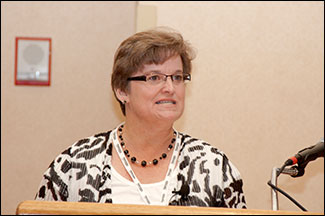Beef’s Fatty Acid Profile
Researcher explains how dietary changes can affect beef’s fatty acid profile.
by Kasey Brown, associate editor, Angus Journal®
LINCOLN, Neb. (June 20, 2014) — Beef, whether finished on grain or grass, is a good source of omega-3 fatty acids, explained Susan Duckett, professor and Ernest L. Corley Jr. Trustees Endowed Chair at Clemson University, to the attendees of the 2014 Beef Improvement Federation Annual Meeting & Research Symposium in Lincoln, Neb., June 18-21.

Susan Duckett, professor and Ernest L. Corley Jr. Trustees Endowed Chair at Clemson University, presented research on fatty-acid profiles and different forage types. While the fatty acid differences weren’t very different, a consumer panel showed that consumers preferred beef finished on alfalfa, compared to other grass-fed beef.
Grain-finished beef has a higher total fat content, with 6.14 grams per 3-ounce (oz.) serving, compared to 2.79 grams per serving of grass-finished beef. However, she said, if a grain-finished steer were fed to grade Select, that steer would be leaner, too. Both are comparable in saturated fat, though in percentage of total fatty acids, grass-fed beef has 34% of monounsaturated fat (MUFA) compared to grain-fed beef’s 42%. Touted heart-healthy oils like olive oil and canola oil boast 70% MUFA, and Duckett said that beef is also a substantial source of MUFA.
Per serving, Duckett explained that grass-finished beef has 71 milligrams (mg) of omega-3 fatty acids and grain-finished beef has 41 mg. Both of these finishing methods are close to or under the recommended ratio of Omega-6 to Omega-3 of 4:1 or less. Both finishing methods are drastically closer to the recommended ratio than either poultry or pork. This is due to ruminant animals eating more forages with Omega-3 fatty acids than monogastric animals.
Duckett presented research on fatty-acid profiles and different forage types. While the fatty acid differences weren’t very different, a consumer panel showed that consumers preferred beef finished on alfalfa, compared to other grass-fed beef.
After a trip to Argentina, she studied supplementation on pasture. Cattle were supplemented 0.75% of body weight per head per day with grain and rumensin and grazed legume or grass pastures. The grams of MUFA per serving were increased with the supplementation by 25%.
Timing of exposure to corn grain affects quality, and more information on this research can be found in the April Angus Journal on page 94, or at www.angusjournal.com/ArticlePDF/Clemson-Finishing-04_14-AJ.pdf.
How do these studies affect human health? If a person ate two 3-oz. servings of beef per day, they would get 142 mg of omega-3 fatty acids per day with grass-finished beef. That person would get 82 mg of omega-3 fatty acids per day with grain-finished. To put this into perspective, a MegaRed Krill oil supplement provides 90 mg of omega-3 per capsule. Moreover, Duckett pointed out, people rarely eat only a 3-oz. serving, so more omega-3 can be sourced from beef.
The 2014 BIF Annual Meeting & Research Symposium was hosted by the University of Nebraska–Lincoln, the U.S. Meat Animal Research Center and the Nebraska Cattlemen June 18-21 in Lincoln, Neb. The Angus Journal and LiveAuctions.tv provide comprehensive online coverage of the event at www.BIFconference.com. Visit the Newsroom for summaries, proceedings, PowerPoints and audio of the sessions; the Awards page for announcements of award winners; and the Photos page for galleries of photos from the meeting and the tours.
Editor’s Note: This summary was written under contract or by staff of the Angus Journal.Through an agreement with the Beef Improvement Federation, we are encouraging reprinting of the articles to those who will adhere to the reprint guidelines available on this site. Please review those guidelines or contact Shauna Rose Hermel, editor, at 816-383-5270. PowerPoints are posted with permission of the presenter and may not be reproduced in whole or in part without the express permission of the presenter.
API's coverage of the event is made possible through collaboration with BIF and sponsorship of LiveAuctions.tv. For questions about this site, or to notify us of broken links, click here.
Headquartered in Saint Joseph, Mo., API publishes the Angus Journal, the Angus Beef Bulletin, the Angus Beef Bulletin EXTRA, and the Angus Journal Daily, as well as providing online coverage of events and topics pertinent to cattlemen through the Angus Journal Virtual Library.



